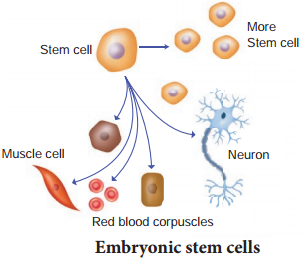Learninsta presents the core concepts of Biology with high-quality research papers and topical review articles.
Stem Cell Therapy
Stem cells are undifferentiated cells found in most of the multi cellular animals. These cells maintain their undifferentiated state even after undergoing numerous mitotic divisions.
Stem cell research has the potential to revolutionize the future of medicine with the ability to regenerate damaged and diseased organs. Stem cells are capable of self renewal and exhibit ‘cellular potency’. Stem cells can differentiate into all types of cells that are derived from any of the three germ layers ectoderm, endoderm and mesoderm.
In mammals there are two main types of stem cells – embryonic stem cells (ES cells) and adult stem cells. ES cells are pluripotent and can produce the three primary germ layers ectoderm, mesoderm and endoderm. Embryonic stem cells are multipotent stem cells that can differentiate into a number of types of cells (Fig. 9.4). ES cells are isolated from the epiblast tissue of the inner cell mass of a blastocyst.

When stimulated ES can develop into more than 200 cells types of the adult body. ES cells are immortal i.e., they can proliferate in a sterile culture medium and maintain their undifferentiated state. Adult stem cells are found in various tissues of children as well as adults. An adult stem cell or somatic stem cell can divide and create another cell similar to it. Most of the adult stem cells are multipotent and can act as a repair system of the body, replenishing adult tissues. The red bone marrow is a rich source of adult stem cells.
The most important and potential application of human stem cells is the generation of cells and tissues that could be used for cell based therapies. Human stem cells could be used to test new drugs.
Stem Cell Banks
Stem cell banking is the extraction, processing and storage of stem cells, so that they may be used for treatment in the future, when required. Amniotic cell bank is a facility that stores stem cells derived from amniotic fluid for future use.
Stem cells are stored in banks specifically for use by the individual from whom such cells have been collected and the banking costs are paid. Cord Blood Banking is the extraction of stem cells from the umbilical cord during childbirth. While the umbilical cord and cord blood are the most popular sources of stem cells, the placenta, amniotic sac and amniotic fluid are also rich sources in terms of both quantity and quality.